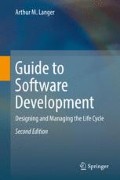Abstract
This chapter builds on Chap. 7 and outlines a step-by-step procedure for designing and developing specifications that reflect the engineering requirements for building systems. This portion of the book provides the necessary tools that analysts and designers need to provide program developers with detailed, yet creative technical specifications toward the processing portion of the requirements document including data flow diagrams, process flow diagrams, the building of a data dictionary, the writing of algorithms, state transition diagrams, and the introduction to entity relationship diagrams. Validating that an application meets requirements is a most difficult process. This chapter discusses alternative ways of accomplishing this task, including creating checklists, quality assurance procedures, group review sessions, and product simulations. The approach is to focus more on what the software does not do, as opposed to its features and functions. The chapter also emphasizes a review of mathematical calculations, that is, the way in which the system handles formulas and produces results. Results also encompass analysis alternatives, types of outputs, and open systems compatibilities.
Access this chapter
Tax calculation will be finalised at checkout
Purchases are for personal use only
Notes
- 1.
Yourdon, Ed (1989), Modern Structured Analysis, pp. 134–35.
- 2.
DeMarco, Tom (1979), Structured Analysis and System Specification, pp. 85–86
- 3.
The case method should not be confused with CASE (computer-aided software engineering) products, which is a software used to automate and implement modeling tools and data repositories.
- 4.
Microsoft Press, Computer Dictionary, Second Edition, pg. 149.
References
DeMarco, T. (1979). Structured analysis and system specification. Englewood Cliffs: Prentice Hall.
Yourdon, E. (1989). Modern structured analysis. Englewood Cliffs: Prentice Hall.
Author information
Authors and Affiliations
Rights and permissions
Copyright information
© 2016 Springer-Verlag London Limited
About this chapter
Cite this chapter
Langer, A.M. (2016). Creating Requirements Documents Using Analysis Tools. In: Guide to Software Development. Springer, London. https://doi.org/10.1007/978-1-4471-6799-0_8
Download citation
DOI: https://doi.org/10.1007/978-1-4471-6799-0_8
Published:
Publisher Name: Springer, London
Print ISBN: 978-1-4471-6797-6
Online ISBN: 978-1-4471-6799-0
eBook Packages: Computer ScienceComputer Science (R0)

